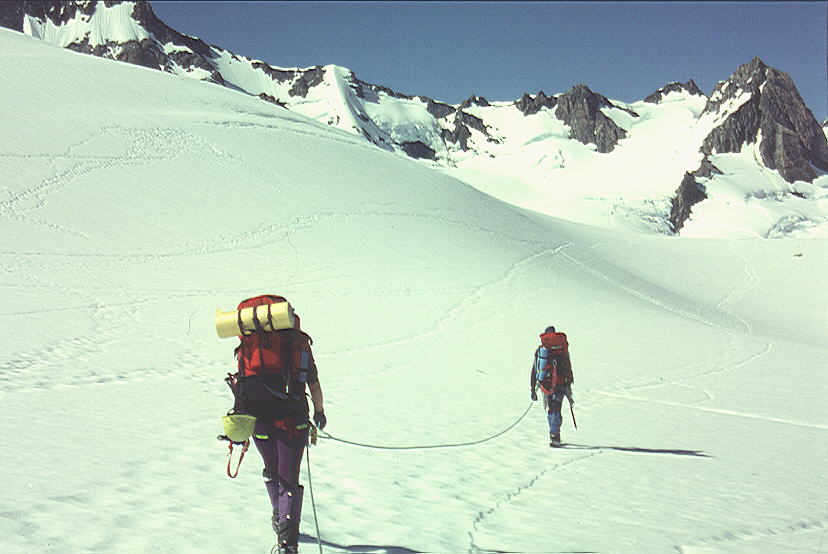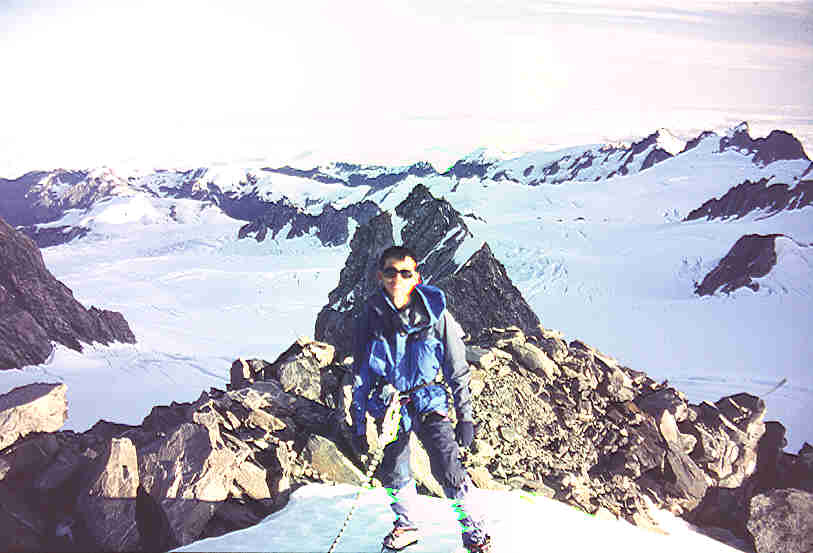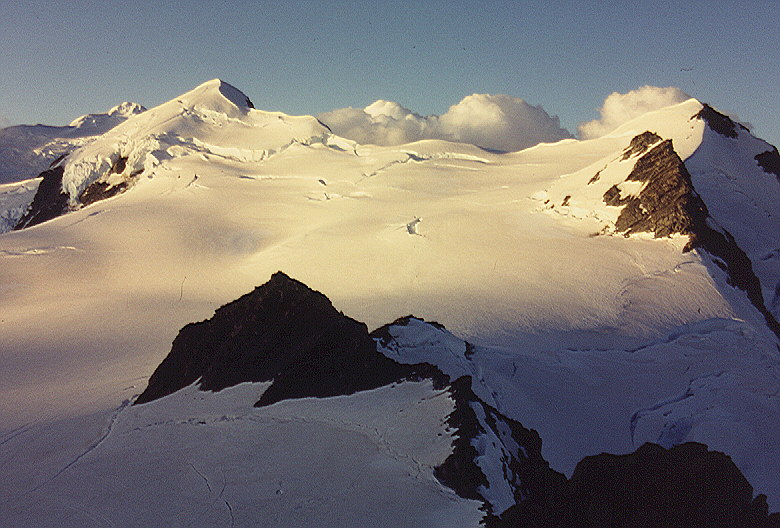|
Climbing in New Zealand,
Southern Alps '92/93
by Wilfred Tok B.C.
The inspiration once
awaked my desire from many books that I’ve read. "The High Mountains of the
Alps", "In Monte Viso’s Horizon", "High Endeavors",
"Savage Arena" and many more,... Indeed these books has brought back memories
and has also inspired more trips to get closer to the mountains into understanding the
natural world and appreciating the delicate nature of life. 1992 saw my first true
experienced of alpine mountaineering. It was a technical mountaineering course that I had
finally booked for myself after 2 years of dreaming and planning. The course was
introduced to me through 2 highly enthusiastic climber’s, Alan Lim and Mok Ying Jang,
who was at that time a vice-chairman and a committee member of SAFRA adventure club
respectively. Since I started rock climbing in 1988, I knew that it’s going to be
additive and certainly extend my potential to the fullest. But what I didn't expect was
the fact that it will become a life long passion.
 
The TMC
course’s had given me a good introduction into alpine mountaineering. Since then I
had planned to return, but I wasn’t confident enough about my exposure in alpine
terrain. I always have a strong feeling that after completing an alpine course
doesn’t put me in a position that I could convince myself by saying that, ‘Look,
you’ve know what you need to know, it’s time to venture out yourselves’.
The strange opposing feeling kept occurring, telling me time and again, ‘Do you know
what you’re doing?, Are you sure you know everything?, Can you handle any situation
out there that is going to catch you by surprise?’ I’m pretty sure that this is
definitely not an uncommon experience for any aspiring climber. After a series of mind
searching for an answer, I told myself, ‘Right, take it easy, need to brush-up on my
fitness, fundamental skills, techniques, so on...’. So how could I do that? I decided
that the best way is to train and developed the necessary stamina at home ground and climb
with experience people from abroad. Finding a suitable partner in Singapore is hell.!!!
It’s as if you’re looking for something that doesn’t exist on this part of
the world. In the year of 1992, only a handful of people in Singapore are exposed to
climbing activities. The other hard facts is that not all experience climbers would favor
climbing with beginner. To be able to find any partnership with a guy more experience than
you, the necessary ground work in term of basic knowledge, skills, techniques and fitness
need to be readily available and at a reasonable level of competency. This kind of two way
assessment can be easily carry out between both party during an outing of a much smaller
scale. The only drawback is that the key component on fitness cannot be easily assess
through a small outing. Despite of all these drawback, people that get this far out into
assessing each other capability and weaknesses, are usually very serious on what their
doing and understand the full consequences.

The
following year of 1993, I return to the southern alps and managed to establish partnership
with an experience local climber from Wellington. I was based in a relatively cheap
accommodation own by the New Zealand Alpine Club, beside the entrance road leading into Mt
Cook village. I came to know about Charlie through Brian's, a local backpacker from
Auckland. We were staying in the same dormitory. Brian told me that a couple of days
earlier he was talking to a guy who was looking for climbing partner, but he wasn't that
lucky! He had gone to do some walking into the Tasman moraine, and only be back by
tomorrow. I thought this was my best shot for a climbing partner. When Charlie got back,
Brian actually introduced him to me. Fortunately, we managed to tied-up quite well. We
started swapping stories till late into the night. Obviously being less experience, I have
nothing much to share with him, except the usual jungle trekking stories to Malaysia and
my TMC course. So, most of the time, he was the guest speaker. We spent the following half
day discussing on our plans and objectives. In the afternoon, we were off for cragging at
the near by cliff.
Together
with Charlie’s, our ski-plane flew into the head of the Tasman glacier and landed on
the Tasman saddle(2394m), right beneath the Kelman Hut. Being cautious and less ambitious,
we selected a couple of easy objectives to get familiar with the weather pattern in the
southern alps. Although Charlie has been climbing in Mt Cook region for more than 2 years,
it has never strike his mind for not observing the weather closely when in the mountains.
Charlie was quite comfortable about my rock, snow, self-arrest skills and techniques. What
we needed now is a period of fine weather window. Everyday climbers in the Kelman hut
received weather forecast through a solar power radio from the weather station in Mt Cook
village. This in a way give climbers, especially those inexperienced party like us, a
useful piece of information to make correct decision and guide us back safely from climbs.

Arriving at
Tasman saddle just after a series of bad weather was definitely lucky for us. There will
be a good period of fine weather for the next four to five days. The following day we were
off to climb Mt Alymer. Mt Alymer is a relatively straight forward peak with mixture of
snow at the bottom and the mid section, a bit of ice at the top before the summit. While
still an objectively safe peak, we spent quite sometime practicing and familiarising all
necessary snow and ice techniques on the lower slope of Alymer. Our next objective which
is connected to Mt Alymer by a long snow ridge running eastwards to the summit of
Hochstetter Dome. The next day we repeated the climb up to the summit of Mt Alymer then,
made a traverse towards Hochstetter Dome. The traverse is a very expose, narrow and
delicate snow ridge, once you get onto the crest of the ridge, one have to place each foot
on both side of the ridge to maintain balance. A fall on the right will bring you plunging
a few thousands feet down the north wall of Alymer, on the left, a steep drop of about a
few hundreds feet into the crevasses of Tasman saddle. The ridge is broken by some small
crevasses, so we did a few crevasses crossing and detoured a big one before gaining the
summit of Hochstetter Dome. We descended by the relatively easy south side and were back
to the hut in time for dinner. We had stocked up about 2 weeks of food supply in Kelman
hut. So when the weather is bad, reading, cooking and eating are the only activities
available to keep you occupied. Of course, exchanging stories, frustration, achievement
and routes details with other climbers never ends..... Sometime you could meet up with as
many as 8 different groups of 6 different nationalities.
The perfect
weather made it possible for us to make yet another early attempt(3.00am) the next day for
Mt Eile de Beaumont, a classic 3117m peak. The climbed was fairly hard with some problems
of route finding through the maze of the heavily fragmented face of ice seracs. The path
that we took were rather dangerous for its huge seracs walls and we almost lost hope when
stumbled onto a huge bergschrund after negotiating the seracs barrier. Charlie’s was
confident that he could cross the bergschrund by its narrowest section. I was quite
impressed by his courage and determination. Kind of "Never say no" attitude, if
you haven't even make an effort to try. With a back-up safety from my belay, he made it
after several attempts. For me, it’s simply a matter of bull strength in pulling and
kicking, which I eventually managed to struggled across with the help of Charlie’s
belay. We were about three quarter of the way up a spectacular snow ridge that leads for
about another 1 km towards the summit plateau, which eventually connects with a huge 100m
ice face that shoot straight up at an inclination of about 60 degree onto the final
summit. We made good progress on the upper section of Mt Eile’s by moving and
climbing together without pitching to safe time. At about 11.30am local time, we reached
the summit of Mt Eile De Beaumont. The sun ray was pretty strong and we knew that we had
to get down very soon, as the snow began to soften. The way down was a slow and agonising
descent across steep sections, crevasses, the seracs barrier and the never ending
snowfields. Snow balls kept forming up beneath our double boots, sinking time and again
deeper into the soft snow. We took about 3 hours to reach a col. between Eile and Mt.
Walter and then rested briefly before taking on an easy route to gain Mt Walter which
ended with a total continuous 15 hours of climbing. Back to the hut I was completely
exhausted. I needed rest for the next full day. We planned to climb Mt Green after our
rest day, but before we knew it, the crap weather set in.
Eventually,
an approaching front started a series of deteriorating weather that stopped all climbing
activities. Being realistic about the situation that was getting worst, I ended my 2nd
season in the southern alps. The journey out of Tasman glacier was rather torturing for a
beginner with marginal fitness, but the supreme beauty of Mt Tasman and the thought about
climbing it has always been in all possible hidden corner of my mind. The motivation of
coming back was so strong that it kept me going despite being in extreme tiredness. I
recalled in the earlier trip’s on one occasion, when I was gazing down at Mt Cook
from the ski-plane. I saw two tiny insignificant figures cling onto the steep east face of
Cook's, approaching the summit from a spectacularly long traverse. It’s a beautiful
route’s that has drawn my attention and my feeling of mixed confident and fear,
...‘Could I do it?' Anyway, I was very optimistic and determine to return for this
classic traverse of Mt Cook, but only with a suitable partner. So,.. there are 2 great
route's to be done! I'll be back.
[ HOME ] [ Back
]

|

